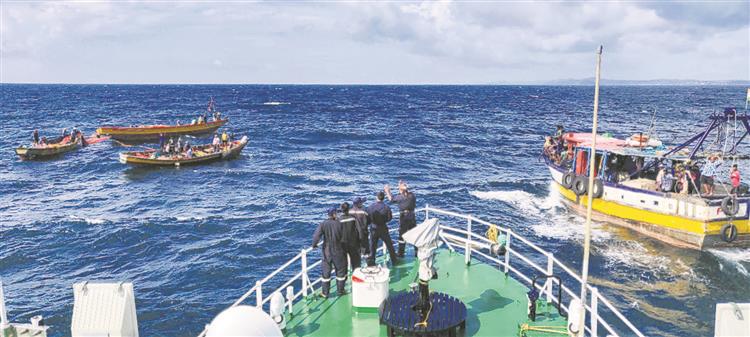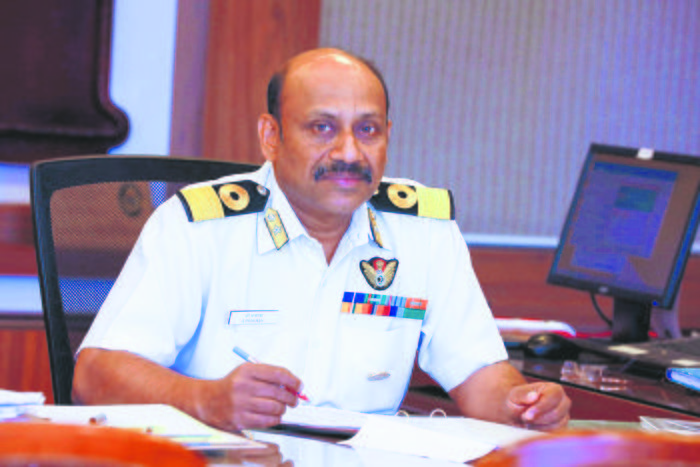INS Kochi had to pick up hundreds of survivors from the churning waters. This was in night-like conditions amid blinding rain. INS Kolkata too chipped in. It was madness. The ships had to work their propellers with utmost care in a sea littered with desperate humans. Through an unreal night in which ships rose and fell many tens of feet and strong wind played with fates, more than a hundred came on board by morning.

Tested to the hilt: Cyclone Tauktae gave the Navy an opportunity to learn valuable lessons about disaster preparedness. PTI

The dance of death unleashed by cyclone Tauktae had hardly begun to sink in when cyclone Yaas crashed into our east coast. As we braced for the fury of Yaas, of great inspiration was the incredible rescue the Indian Navy had pulled off from the very heart of Tauktae off Mumbai. The weather and sea conditions that prevailed would make the hardiest seafarer disbelieve even a fraction of the final success achieved. Despite my 35 years in the Navy, with time on board ships, Sea King helicopters, command and control centres and various headquarters, I too find the success stupendous.
For the record, the Navy rode right into the raging cyclone, rescued 188 people, retrieved 70 bodies, gave logistic support to stricken craft and provided professional advice. By sheer chance, I had a ringside view of Tauktae from a 10th-floor flat near Land’s End, Colaba, Mumbai. With howling wind and blinding rain all around, I watched big naval ships and Sea King helicopters with awe, as TV showed glimpses of their deployment. As the winds subsided and the last of our ships got back to harbour, there were accounts from the warriors of the sea in person. Warriors who had risked their lives, warriors who had led their flock literally into a storm.
As Tauktae had swept up the west coast, steadily gathering strength, Indian Navy helicopters had already rescued people off Mangalore and Goa. Prudently, the Western Naval Command prepared for what was to come. They absorbed the copious information that flowed from Naval Headquarters, New Delhi, through the Navy’s Information Management and Analysis Centre (IMAC) at Gurugram. They ensured that ships, aircraft, personnel, equipment and special stores were ready and took care to see that their assets on land and in harbour remained safe.
The formidable Western Fleet, the strongest force any Two Star Admiral has in this world, was to be at the core of the oncoming effort. In support were the venerable Sea King helicopters with a glorious past in amazing rescues and the powerful P8I aircraft for prolonged surveillance of large sea areas. It was providence that this strong force was available, for no one else in India could have faced what was coming. Hundreds of people working offshore were about to face mortal danger very soon.
The first responder was the 8,000-tonne destroyer, INS Kochi, which sailed out of Mumbai harbour around 11.30 am on May 17. Safely getting out of the harbour itself was a near impossibility. As she let go her ropes that kept her safely tied to the jetty, four strong naval tugs struggled to handle the heavy ship in the 80 to 100 kmph winds that randomly kept changing directions. Her Captain had to choose a burst of high engine power, normally used in open waters, to break out of the confines of the naval dockyard. In the blinding rain that reduced the visibility to night-like conditions, the Captain probably would have laid faith in fervent prayer too. The long channel leading out to sea was littered with civil craft dragging their anchors and getting in the way. INS Kochi weaved through this chaos. An iconic photograph of INS Kolkata, setting out from Mumbai harbour about two hours after Kochi, captures the conditions for posterity. Little would these ships have known that this was probably the easiest thing they and those that followed them were to endure in the next 72 hours.
While the exact events of the following days in the entire area must be chronicled, analysed and investigated, I must pay tribute to the sheer human spirit and some robust systems that held out in the face of extreme adversity.
There was great competence of the ships. INS Kochi, which reached a sinking accommodation barge P305 in the afternoon, had to pick up hundreds of survivors from the churning waters a few hours later. This was in night-like conditions from blinding rain. Real night too closed in soon. INS Kolkata, which too reached the area, chipped in. It was madness. The ships had to work their propellers with utmost care in a sea littered with desperate humans. They would spot a group of survivors, manoeuvre their ship windward of them, and slowly drift in their direction. Getting people on board wasn’t easy. Everything was tried. Experienced marine commandos, professional divers and even non-divers jumped into the mad sea. Nets were used to virtually fish people out of the sea. Through an unreal night in which floating survivors and ships rose and fell many tens of feet and strong wind played with fates, more than a hundred came on board by morning.
The first Sea King helicopter, a multirole 42B, took off from INS Shikra early morning on May 18 in dangerous operating conditions which lay beyond what the manufacturer advices. The Sea King picked up three survivors from near INS Kolkata, supplied the ships with body bags and returned to Mumbai. Two Sea Kings will ultimately go on to save 39 people.
There were also other relief activities going on elsewhere. All this was managed by the 4,000-tonne Indian Navy ships — Talwar, Betwa and Teg — and Beas.
Captains of ships struggle for words to express the enormity of the fortitude they saw around them. Hygienist sailors packed decomposing bodies! Medical officers and staff diligently recorded cues that could help identify bodies later, engineers and their crew who remained below decks in murderous conditions to keep the machinery going, seamen risked their life, chefs cooked in hellish conditions, quartermasters who steered the ships delicately among floating humans, and sailors and officers of every hue, who made the Navy proud with their courage and selflessness. Similarly, it was the collective effort of hundreds of professionals on ground that enabled every Sea King to take to the sky. Senior Operational Staff Officers who lived next to their office phones for four days and senior leadership who gave the most important gift to those on the field, autonomy borne of trust, completed the matrix.
Everything couldn’t have been perfect. While the Navy will assiduously find lessons for future use, the country must plug the holes that exposed hundreds to unnecessary danger. Even with all that, no one can be sure of a disaster-free future. But what we can be sure of is a strong Navy that will deliver, under any circumstance, like nobody else can. Well done, Shano Varuna!
